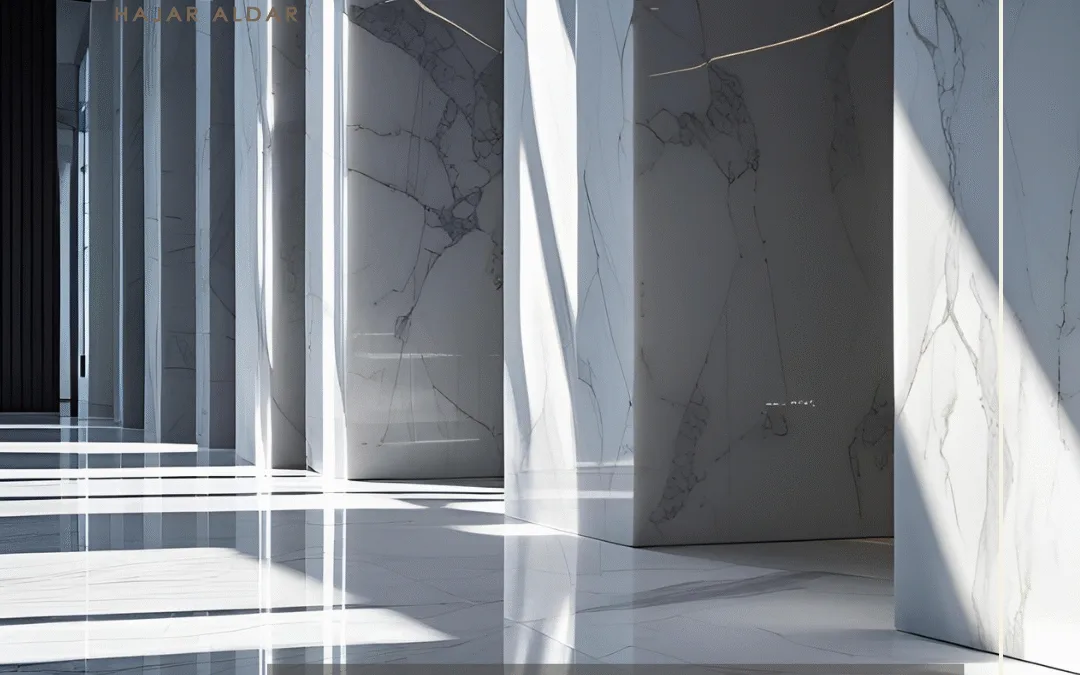The Impact of Lighting on the Appearance of Marble in Indoor Spaces
Introduction
Marble, with its natural veins and diverse colors, is not just a material that covers floors or walls—it is a living artistic element that interacts with its surroundings. In indoor spaces, lighting becomes a crucial factor that can either enhance the beauty of marble or completely diminish it. The type, intensity, and direction of light greatly affect how marble appears and how we perceive it within the space.
In this article, we will discuss the vital relationship between marble and lighting, how different types of lighting affect the marble’s look, and the best ways to highlight marble indoors using smart and appropriate light distribution.
First: How Does Marble Interact with Light?
Marble is a natural, semi-translucent material in some varieties and contains veins and colors that differ in how they absorb and reflect light. This means:
-
Marble can reflect light, making a space appear larger and brighter.
-
Or it can absorb light, creating a warm and mysterious ambiance depending on the marble type and lighting used.
-
Some types, like onyx marble, allow light to pass through, creating enchanting visual effects when backlit.
Second: Types of Lighting and Their Effects on Marble
-
Natural Lighting (Daylight)
-
Provides marble’s purest and most authentic appearance.
-
Natural light reveals the true colors of marble without distortion.
-
In indoor spaces, windows or openings should be designed to direct light toward marble surfaces.
-
Using light-colored marble near daylight openings doubles the sense of spaciousness.
-
Warm Lighting (Yellowish Light)
-
Adds a visual warmth to marble, especially white and beige tones.
-
Enhances marble with brown or golden veins.
-
Ideal for spaces aiming to create a cozy atmosphere like living rooms and bedrooms.
-
Cool White Lighting
-
Makes marble appear sharper and more defined.
-
Highlights fine veins in gray or black marble.
-
Suitable for bathrooms, offices, or modern kitchens.
-
Backlighting
-
Especially used with onyx or translucent marbles.
-
Gives marble an inner glow, creating a dramatic and impressive effect.
-
Used on decorative walls, reception desks, or as luxurious TV backdrops.
Third: Lighting Direction and Angle Effects
Lighting’s importance is not just in type but also in the angle of incidence:
-
Direct overhead lighting: Shows marble surface evenly but may hide fine veins.
-
Side lighting (Wall wash): Highlights natural veins and lines, enhancing visual depth.
-
Spotlighting: Focuses light on a specific marble area to emphasize a particular beautiful feature such as a table or marble column.
Fourth: How Does Lighting Affect Marble Colors?
-
White Marble:
Glows under natural or cool white light; appears warm and cozy under yellow light. -
Black Marble:
Needs strong directed light to reveal details; may look flat and too dark under dim lighting. -
Gray Marble:
Takes on an industrial feel under cool light; appears more elegant and calm with warm light. -
Colored Marble (Green, Pink, Blue):
Requires balanced lighting to show true colors without distortion; backlighting may enhance translucency and color depth.
Fifth: Marble Lighting in Different Rooms
-
Entrance Hall:
Soft direct lighting on a marble panel creates a luxurious first impression. -
Bathrooms:
Marble shines under white light, especially around mirrors and sinks; use LED strips behind marble in specific spots for a modern spa feel. -
Living Rooms:
A mix of warm and side lighting highlights marble walls or light floors. -
Kitchens:
Marble countertops and islands look stunning under focused pendant lighting.
Sixth: Common Mistakes When Lighting Marble
-
Using overly bright white light on warm-colored marble, making it appear dull.
-
Relying solely on general lighting without dedicated marble accent lighting.
-
Ignoring reflections from polished marble surfaces, causing annoying glare.
-
Overlooking some marble types’ light absorption, which can make the space seem gloomy.
Seventh: Technology and Smart Lighting
Today, smart lighting systems can adjust color temperature and brightness according to time, mood, and space. This gives full control over how marble appears at every moment:
-
“Daylight” setting to clearly highlight marble.
-
“Evening” setting with warm light to enhance vein warmth.
-
Dynamic light effects on marble walls for formal gatherings.
Conclusion
No matter how luxurious and high-quality marble is, it cannot fully express its beauty without proper lighting. Indoors, lighting becomes a key partner in design, determining how we see and feel marble. From natural to smart lighting, from backlighting to spotlights, every light tells a new story of marble and reveals a different facet of its magnificence.
If you plan to use marble in your interior design, think of lighting as the painter’s brush… With it, the marble’s features are drawn, and the true magic of the space is born.


